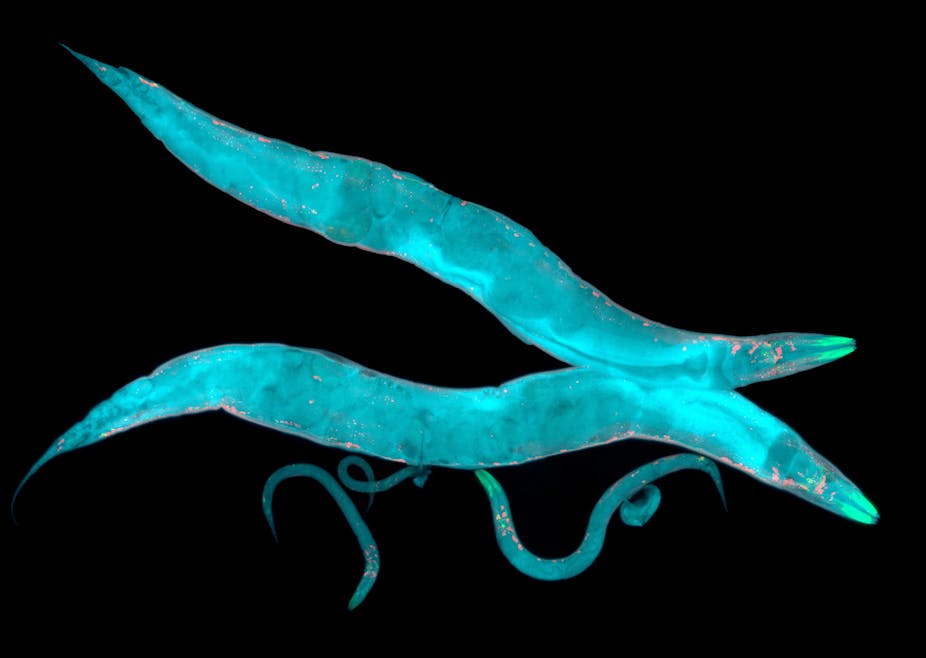Nematodes are tiny little creatures that could one day be our space pioneers telling us whether or not we can settle on other planets. They are one of the multicellular organisms that can claim to have been into outer space, and then to have successfully returned to earth.
The reason they are chosen for missions into space is that they are model organisms. Their complete genome sequence is known, and the effect of space travel on their DNA can easily be determined. They have travelled on several space missions, mostly in orbit around the earth. In 2003, they managed to be the sole survivors of the Columbia flight that crashed in Texas, when they succeeded in making it back to earth alive.
In future they will be sent on unmanned missions to the moon or Mars to determine the effect on their DNA and to establish whether humans would be able to survive such a flight.
But way before they are considered as explorers, let us examine the role nematodes play here on our own planet.
What they are and why they matter
Nematodes are the subject of many fields of study. They are mostly cylindrical and wormlike. They can vary in size from a few millimetres to 8 metres - that’s the length of 1 000 earthworms laid end-to-end. They can be divided into three groups depending on their habitat - parasites on vertebrates, free living nematodes or plant-parasitic nematodes.
Most people have never heard of nematodes. But they can recall disturbing pictures from the internet of parasites in humans or animals that are mostly from the tropics. They may not even know it, but these are nematodes.
Nematodes can be regarded as animals, generally called round worms. There are males and females. Physically both possess a head and a tail. The female of the species possesses a vulva, whereas the male possesses spicula, both for the purpose of reproduction. Their main aim on earth, as seen from the human perspective, is to succeed in hiding from detection - and to breed in enormous quantities to secure their own survival.
These small creatures play an important role in all biological systems, especially in the soil where they perform a strategic function as part of an important ecosystem service to keep soil healthy. They do this by limiting insect, bacterial and fungal populations. They also often act as predators of their own kin.
Nematodes play a pivotal role in the control of weeds by moving above ground in a thin film of water and infecting vast quantities of seeds. This effectively prevents the weeds from germinating.
The physical limitations of nematodes, such as their basic, wormlike body equipped with a hydrostatic skeleton without any appendices, does not stop them inhabiting every niche on earth. This ranges from parasiting warm as well as cold-blooded vertebrates, to living in vinegar and in the mats under the taps of beer casks.

They are believed to have originated in the sea, and they still always need to be close to water to feed and breed. But their need for water is also their Achilles heel, and it is about one of the only things that prevents them from taking over the world. In some cases nematodes have developed ingenious ways of overcoming dry spells, and they can be brought back to life, as it were, in a seemingly miraculous way when water becomes available.
Resilient beyond belief
Nematodes are on record for being able to be revived after 32 years in wheat seeds stored in a refrigerator.
But be warned if you want to learn more about these creatures and heed the words of N.A. Cobb, the father of Nematology:
If all the matter in the universe except the nematodes were swept away, our world would still be dimly recognisable, and if, as disembodied spirits, we could then investigate it, we should find its mountains, hills, vales, rivers, lakes and oceans represented by a thin film of nematodes. The location of towns would be decipherable, since for every massing of human beings there would be a corresponding massing of certain nematodes. Trees would still stand in ghostly rows representing our streets and highways. The location of the various plants and animals would still be decipherable, and, had we sufficient knowledge, in many cases even their species could be determined by an examination of their erstwhile nematode parasites.
Despite a great many people knowing very little about nematodes, scientifically they’re one of the most dominant model organisms that are used in a whole range of research. Most scientists are familiar with at least one member of the nematode family, the Caenorhabidits elegans. They are used in the study of embryogenesis within the field of genetics. Embryogenesis starts with the fertilised egg and its development to a worm, which in the case of C. elegans takes about 1000 somatic cells with a short life cycle of three days.
Nematodes can be both good and bad. They can be a menace to agriculture, such as the plant-parasitic nematodes that damage the roots of food crops lowering yields. Or they can be used to our advantage to biologically control insects, to control slugs and weeds, and to measure the health of soil.

